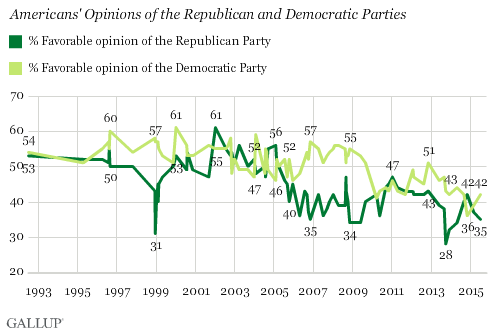Story Highlights
- Democratic Party seen more favorably than GOP, 42% to 35%
- Dems' rating has risen slightly from November 2014 low of 36%
WASHINGTON, D.C. -- As the 2016 presidential race increasingly dominates political news, the favorable ratings for both major parties are still close to their historical lows. Slightly more than four in 10 Americans (42%) view the Democratic Party favorably, while the Republican Party has a favorable rating of 35%. The rating for Democrats is up slightly from , while the Republican rating fell two percentage points. The net result is Americans now view the Democratic Party more favorably than the GOP.

These results come from a July 8-12 poll. After their substantial losses in the 2014 midterm elections, Democrats have seen a slight improvement in their political standing. Democrats recently regained the edge in , while the approval rating of Democratic President Barack Obama has been over the course of this year compared with last.
The Democrats' current favorable rating is more in line with how the American public has seen the party over the course of the Obama presidency. The Democratic Party enjoyed a favorable rating higher than 50% in 2009, but it then fell to the low 40s in 2010. It languished near that level over the next several years, aside from a brief spike in November 2012 to 51% after Obama's re-election.
Meanwhile, Republicans have seen their slight boost in popularity last fall reverse itself. But recent political history shows that Republicans' favorable rating can be fluid. During the government shutdown of October 2013, Republicans saw their favorable rating . For a brief time, there was chatter among some political pundits that the GOP might fail to pick up seats in Congress in 2014, which would have been a rarity for the opposition party in a midterm election.
But beginning in late 2013, Republicans saw their favorable rating steadily rise as the Obama presidency was beset with problems. These included the rise of the Islamic State group in Iraq and Syria, and the subsequent execution of American hostages by that terrorist organization; the in the U.S., and evidence that the Veterans Administration falsified reports to conceal the waiting times veterans endured to receive medical attention. By November 2014, the American public saw the Republican Party more favorably than the Democratic Party -- a rare occurrence in Gallup's trend dating to 1992. The parties' current positioning is a reversal of what it was in November.
Bottom Line
The Democratic Party has regained its edge over the Republican Party in terms of favorability, another sign that it is recovering from its poor 2014 showing. But both parties remain unpopular relative to their historical performance, which suggests neither has the wind at its back going into the 2016 presidential contest.
Survey Methods
Results for this 优蜜传媒poll are based on telephone interviews conducted July 8-12, 2015, with a random sample of 1,009 adults, aged 18 and older, living in all 50 U.S. states and the District of Columbia. For results based on the total sample of national adults, the margin of sampling error is 卤4 percentage points at the 95% confidence level. All reported margins of sampling error include computed design effects for weighting.
Each sample of national adults includes a minimum quota of 50% cellphone respondents and 50% landline respondents, with additional minimum quotas by time zone within region. Landline and cellular telephone numbers are selected using random-digit-dial methods.
View complete question responses and trends.
Learn more about how works.

